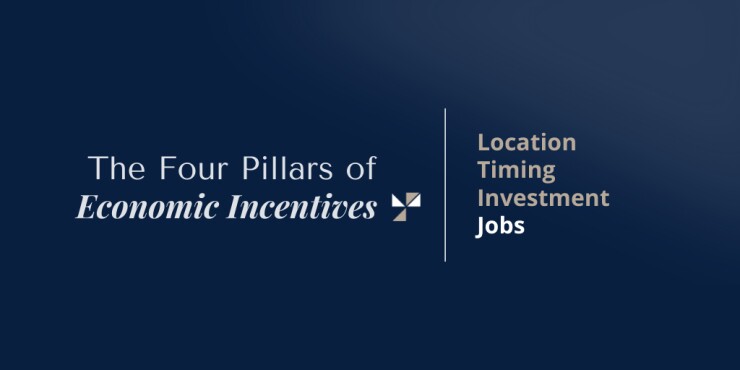Employees are the single most important factor contributing to a business’s success. Employees drive value for their employer by sharing their experience, wisdom, productivity and, most importantly, their innovation. These intangible qualities are recognized in the new cultural buzzword “human capital.” Without employees, businesses are impersonal, cold and transactional.
Because employees provide so much economic value to a business, they also are the primary driver for another kind of value: credits and incentives. State and local communities celebrate when businesses grow through the addition of new jobs. New jobs, and the associated wages created with those jobs, are the greatest influencers of discretionary and statutory credits and incentives programs.

To understand why jobs are so essential for economic credits and incentives programs, let’s look at the ripple effect they have on a community. Consider a growing manufacturing company that is finalizing a new contract with a large original equipment manufacturer (OEM). The business knows that to meet the new demands from the OEM, it will have to expand its facility. It can either expand at its current plant or look to establish a new location closer to the OEM to reduce the cost of transporting finished goods. Under the contract, the manufacturer also will need to invest upward of $15 million in new machinery and equipment, which will require the addition of workers to operate the machinery, handle materials, warehouse finished goods and even engineer new required products or processes. With all these demands, the manufacturer may need to add new management and administrative staff as well.
Overall, the manufacturer estimates it will need to add 40 to 50 new jobs. Before the project begins, the manufacturer is in a perfect position to explore economic credits and incentives programs: It has several options on location, must make new investments, and knows it needs more workers to operate successfully.
Communities will compete to bring this company to their area. Why? New workers in an area are likely to add value to the greater economy. Chances are they will move to the community and rent or purchase housing. Their presence in the community will also drive further demand for the local retail, residential and commercial developments, which in turn create further benefit for the community through property taxes, sales and use taxes, food and beverage taxes, etc. Ultimately, new tax dollars are generated from the net new payroll and increases to business productivity (corporate business income taxes). These new tax revenues allow communities to invest in their amenities and services, such as schools, parks, infrastructure, public safety and other beneficial resources.
As illustrated in this example, communities grow when businesses grow. Many communities want a diverse and vibrant population — a healthy indication of a growing community. Growing communities attract more investment, and the cycle continues.
Economic credits and incentives for job growth play a significant factor in business location and growth decisions. In states across the country, job creation programs can bring thousands of dollars in tax credits, refunds or even cash per new job created. In Arizona, the job creation program can deliver up to $9,000 per new job in tax credits. In the Midwest and Great Plains states, the value is created by payroll tax withholding that is retained by the business rather than being requested as a tax credit each year. In Southern states, a set amount of payroll taxes paid to the state or community is issued as a refund check (cash back) to the company. Programs vary from state to state and often have minimum job creation, wage or investment requirements. They also involve strict reporting and compliance documents that require timely filing. For these and other reasons, it’s important to bring a trusted credits-and-incentives expert to the table early in these conversations with clients.
With net new jobs acting as the primary factor for economic credits and incentives awards, what happens in an economy when it is difficult to find new employees to fill these jobs? As we’ve seen this year, businesses are having difficulty finding and retaining qualified employees. This has pushed many to consider automation over employment growth. Automation still requires investment (another key driver for economic credits and incentives projects) and human capital, albeit with a smaller net new headcount.
However, the workers required to operate this new equipment will need to have higher skill sets, which often command higher wages. The employer has the option to invest in (or “skill up”) their existing workforce by training lower-skilled workers for these higher-skilled jobs. This new training requirement, whether it is on the job or more formal education, is also attractive to economic credits and incentives programs, which might reimburse the cost of specialized training.
Dynamic, growing companies typically have opportunities for credits and incentives benefits if the key triggers we have discussed are detected early. The essential piece is to be in front of the project — working through the estimation, application and negotiation processes with economic credits and incentives decision-makers prior to new job growth or investment. It all begins with proactive CPA advisors who help their clients to identify job growth opportunities before they happen, then coordinate with a trusted credits and incentives team to maximize client value and tax savings.




